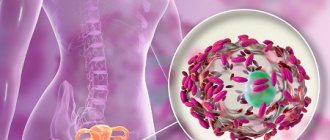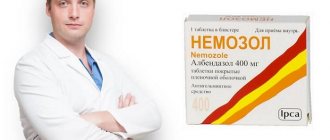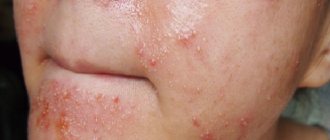Glycogen storage diseases (glycogen diseases, glycogenosis, HD, ICD-10 E74.0) are a group of hereditary diseases of carbohydrate metabolism, the pathogenetic mechanisms of which are based on a defect in genes encoding enzymes that regulate the main processes of glycogenogenesis and glycogenolysis [1, 2]. The overall incidence of glycogenosis, depending on the type of disease, is 1 case per 20,000–43,000 living newborns [3, 4].
The consequence of disturbances in the processes of synthesis or breakdown of glycogen is its excessive accumulation in organs and tissues, mainly in the liver and muscles. Currently, 15 types of HD are distinguished according to the chronological sequence of the discovery of the phenotype, which are classified as liver, muscle or mixed forms [3, 5, 6].
Glycogenosis that occurs primarily with liver damage includes types I, III, IV, VI and IX. The course of the disease has its own characteristics, determined by pathogenetic reactions and the presence of compensatory mechanisms for each type. Severe type I is characterized by pronounced and frequent episodes of hypoglycemia, which is caused by blocking the processes of glycogenolysis and gluconeogenesis, while in types III and VI–IX gluconeogenesis processes are not affected and allow maintaining glucose levels within the reference values for much longer. Each type of disease has its own subtypes, which also determines the polymorphism of the clinical picture.
Characteristic symptoms of the disease are severe delay in physical development and growth retardation in this group of patients, manifestations of osteopenia from an early age, complaints of severe weakness and poor tolerance to physical activity, increased morbidity, dry skin, frequent nosebleeds, severe sweating, changes in stool character . Objectively, there is an increase in abdominal circumference due to hepatomegaly, expansion of the venous network of the anterior abdominal wall (mainly in patients with type I disease), capillaritis of the palms and feet [7, 8].
Hypertension is a serious disease, in most cases leading to disability of patients and requiring complex lifelong treatment [9]. Pathogenetic treatment for hepatic forms of HD has not currently been developed. The basis of treatment is diet therapy, which requires early intervention, long-term monitoring and making the necessary adjustments during the growth and development of the patient suffering from this hereditary disease [10–12]. Diet therapy in patients with hypertension can minimize metabolic disorders associated with the course of the disease, as well as reduce the risk of developing delayed complications [13, 14]. An important correction method for many years has been corn starch replacement therapy [15]. Sucrose is excluded from the diet of patients with hypertension and the consumption of fructose and galactose is strictly limited [16].
Diet therapy in patients with storage diseases should be based on a detailed study of nutritional status and include a set of diagnostic measures: anthropometry, assessment of actual nutrition, study of body composition, measurement of basal metabolism using indirect calorimetry, continuous monitoring of glucose levels, determination of the level of macro- and micronutrient composition of blood serum [17]. In children with hepatic forms of hypertension, due to genetically determined enzymatic disorders and metabolic changes, there is a deficiency of various macro- and micronutrients, including vitamins [18]. To date, there are few studies in the domestic and foreign literature devoted to the assessment of vitamin status in children with hypertension [19–21]. Studying this issue allows us to determine principles and formulate recommendations for optimizing the diets of children with hypertension in order to enrich them in vitamin, macro- and micronutrient composition, which will improve the quality of life and prognosis of the disease.
The purpose
of the study
was to assess the vitamin status of children with hepatic forms of hypertension.
Material and methods
A study of vitamin status was carried out in 81 patients, of which 55 were boys and 26 were girls. The number of children with type I headache was 20 people (24.7%), with type III - 15 people (18.5%), with types VI-IX - 46 people (56.8%). Due to identical clinical manifestations of types VI and IX of headache, these children were combined into one group. In the group of patients with type I disease, there were 6 boys and 14 girls; in the group of patients with type III, there were 7 boys and 8 girls; in the group with types VI–IX HD there were 42 boys and 4 girls. The median age of children was 5.0 [2.3; 8.5] years. The median age for type I disease is 6.0 [1.4; 8.2], with type III - 3.0 [2.0; 6.3], with types VI–IX – 5.0 [2.6; 11.0].
The concentration of vitamin E (the sum of the content of α- and γ-tocopherols) was determined using high-performance liquid chromatography, the content of vitamin C (the sum of ascorbic and dehydroascorbic acids) in blood serum was determined by the photometric method using the “Vitamin C” kit (Immundiagnostik AG, Germany). The concentration of vitamin B2 (riboflavin) was assessed spectrofluorimetrically using riboflavin-binding apoprotein, the folate content in the blood serum was assessed by a microbiological method using the ID-Vit Folic acid kit (Immundiagnostik AG, Germany). To determine the concentration of vitamin B12 and 25-hydroxyvitamin D in blood serum, an enzyme-linked immunosorbent method was used using the “ID-Vit Vitamin B12” (Immundiagnostik AG, Germany) and “25-Hydroxy Vitamin D EIA” (Immunodiagnostic systems, UK) kits. The content of 4-pyridoxylic acid and 1-methylnicotinamide in the morning urine was assessed using fluorescent methods.
Samples were checked for compliance with the law of normal distribution using the Shapiro-Wilk test. In all cases, the distribution differed from normal, so the median and interquartile range were used when describing the data. When comparing more than two groups, a nonparametric method of analysis of variance was used - the Kruskal-Wallis test; for post hoc comparisons, Dunn's test was used. Correlation analysis was performed using Spearman's test. To solve the problems, the software used was Statistica v10.0, GraphPad Prizm v7.0. Two-sided significance levels were assessed. P values <0.05 were considered statistically significant, and in all cases the absolute values of the achieved significance levels were reported.
Standard Treatments
Because the symptoms of Hers disease are usually mild, the disorder usually does not require treatment other than avoiding prolonged fasting and monitoring by a doctor. People experiencing hypoglycemia during fasting may be advised to eat foods high in carbohydrates frequently.
Genetic counseling may also be helpful for affected individuals and their families. Other treatment is symptomatic and supportive.
Research results and discussion
The results obtained (Table 1, Fig. 1) indicate adequate levels of vitamins C, B12 and folic acid in the general group of patients with hypertension. The median concentration of vitamin E in blood plasma reached the upper limit of reference values. Tocopherol levels were significantly higher in the girls group (p=0.0439), an excess was observed in 59% of cases, the maximum level of increase was 3.6 mg/dl. Exceeding the normal limit of vitamin E (maximum up to 2.7 mg/dl) in the group of boys was detected in 35% of patients. A decrease in the concentration of the transport form of vitamin D was recorded in 78% of cases in the general group of patients with hypertension; normal values were observed in 9 (17.3%) boys and 8 girls (33%). There were no significant differences in vitamin D levels depending on gender. A decrease in the concentration of riboflavin in the blood serum was observed in 25% of boys and in 61.5% of girls; there was a tendency to a more pronounced decrease in concentration below the threshold values in girls, but no significant differences were obtained during the analysis (p = 0.0550). The results of assessing the level of riboflavin in urine samples indicated a significantly more pronounced decrease in this indicator in the group of girls with hypertension (p = 0.0023). A decrease in urinary excretion of riboflavin was recorded in 20% of boys and 80% of girls. A decrease in the excretion of 4-pyridoxylic acid was recorded in 3/4 of the children; a significantly more significant decrease was noted in the group of girls (p = 0.0065). It should be noted that reduced excretion of this indicator may be due to both insufficient vitamin B6 in the diet and a deficiency of vitamin B2, the coenzyme forms of which are involved in the metabolism of pyridoxine. A decrease in urinary excretion of 1-methylnicotinamide was noted in 90% of patients with hypertension; no significant differences in the level of decrease depending on gender were detected. A likely cause of nicotinic acid deficiency may be the dietary habits of patients with hypertension, whose diet is predominantly high-carbohydrate, rich in grains, with a relatively low amount of animal proteins.
When assessing the vitamin status of patients with hypertension depending on the type (Fig. 2), the highest percentage of cases of increased vitamin E levels (62%) and decreased vitamin D concentrations (87%) was recorded in type III of the disease. In patients with type I HD, the deficiency of vitamin B2 (73%) in the blood plasma is most pronounced and, as a consequence, the maximum percentage of cases of deficiency of metabolites B2 (75%) and B6 (87%) during excretion in urine. A decrease in the concentration of 1-methylnicotinamide in urine was observed in a high percentage of cases in all types of the disease, which is a possible result of the high content of carbohydrates and starch in the diet of patients.
In the process of comparative analysis (Table 2) of the concentration of vitamins depending on the type of hypertension, significant differences in the level of riboflavin in the blood plasma and urine were revealed, which, in a pairwise comparison, taking into account the significance level of multiple comparisons, reflected significantly lower vitamin levels in the group with type I hypertension. in relation to the group with types VI–IX headache (p=0.0158, p=0.0009). A significantly lower level of 1-methylnicotinamide was observed in type I headache compared to III (p=0.0139) and VI–IX types of headache (p=0.0147). These indicators reflect the weakest supply of B vitamins in patients with type I, which is characterized by the most severe clinical manifestations.
Analysis of vitamin E levels depending on the type of disease did not reveal statistically significant differences (p=0.2607). In all types, there was a significant increase in vitamin E levels, which correlated with high plasma triglyceride (TG) levels (r=0.2956, p=0.0207) (Fig. 3). When expressing the content of tocopherols per TG, vitamin E deficiency was detected 2.1 times more often (in 18.9% of cases in the general group of patients), mainly in patients with hypertension types I and III.
Analysis of vitamin D provision did not reveal significant differences in the comparison groups; for all types, there was a decrease in the concentration of the indicator below threshold values, which was seasonal (Fig. 4). Thus, the level of vitamin D reached normal values in the summer and had a pronounced tendency to decrease in the autumn-winter and spring periods.
Large-scale studies that have been conducted in population samples from various countries indicate statistically significant correlations between vitamin D deficiency and decreased bone mineral density, which is of great importance for patients with hepatic forms of HD. We conducted an analysis aimed at identifying the dependence of bone mineral density in patients with hypertension on the level of the transport form of vitamin D in the blood plasma. The Z-score criterion was used, reflecting the standard deviation of the patient’s indicators from the average age norm. There was a statistically significant decrease in bone mineral density at low concentrations of vitamin D in the general group of patients (r=0.4764, p=0.0022). Analysis in groups depending on the type confirmed the presence of a correlation in patients with types I (r=0.7448, p=0.0267) and VI–IX (r=0.4786, p=0.0209) types of headache (Fig. 5 ).
When analyzing the concentration of vitamins depending on the age factor, a statistically significant inverse relationship between the level of riboflavin in the blood plasma and age in children with hypertension is observed (r = -0.4677, p = 0.0020). There is a significant decrease in riboflavin levels with age in patients with types I (r=-0.7834, p=0.0065) and VI–IX (r=-0.4738, p=0.0259) of the disease (Fig. 6) . When analyzing the level of riboflavin in urine, a significant decrease in the concentration of the vitamin with age was noted only in type I HD (r=-0.7042, p=0.0135) (Fig. 7).
When analyzing the level of vitamin D depending on age, a significant decrease in vitamin concentration with age was noted in patients with type I (r=-0.7149, p=0.0017) of the disease (Fig. 8).
The results of the analysis of vitamin status in patients with hepatic forms of hypertension indicated the presence of vitamin deficiency in 94% of patients. A combined deficiency of two vitamins was noted in 81% of cases, three or more vitamins - in 56% of cases. An adequate level of provision with vitamins C, B12 and folic acid was noted in the general group of patients and depending on the type of disease.
An increase in vitamin E content was noted in 43% of cases among patients with hypertension, the median concentration reached the upper limit of the reference values. The highest percentage of cases of increased vitamin E levels (62%) was recorded in type III of the disease. A comparative analysis of the level of vitamin increase did not have significant differences depending on the type (p = 0.2607). These changes are characteristic of the development of hyperlipidemia, which is accompanied by an increase in the level of lipoproteins involved in the transport of tocopherols [22, 23]. The analysis reflected the presence of a direct correlation with a high level of triglycerides in the blood plasma (r = 0.2956, p = 0.0207), while when expressing the content of tocopherols per TG, vitamin E deficiency was detected 2.1 times more often, predominantly in patients with hypertension types I and III. It is necessary to note the significant role of vitamin E in the antioxidant system. In patients with type Ib headache, a number of studies have demonstrated the effectiveness of vitamin E administration in therapeutic dosages (600–900 mg/day) in order to increase the level of neutrophils, protect neutrophils from apoptosis and improve their function, reduce the incidence of recurrent severe infections and inflammatory changes in the intestine [19, 24]. The use of granulocyte colony-stimulating factor in patients with type Ib hypertension in cases of severe neutropenia does not prevent the induction of apoptosis in circulating neutrophils and carries the risk of a number of side effects. Administration of vitamin E can reduce the frequency and dosage of granulocyte colony-stimulating factor, improving the patient's quality of life. An important point when prescribing vitamin E is the use of natural forms. Synthetic vitamin E is not a biochemical equivalent of natural forms, but is a mixture of 8 stereoisomers, only one of which is equivalent to D-alpha tocopherol. Natural vitamin E is more effective than synthetic vitamin E, it is the main safe antioxidant, which consists of 8 different components. In this case, taking only alpha-tocopherol at a dosage of 400 IU significantly reduces the concentration of γ- and δ-tocopherol in the blood serum. High levels of α-tocopherol in the blood may indicate a deficiency of other components of the vitamin, which, in turn, can cause clinical manifestations of vitamin E hypovitaminosis. In this regard, the administration of natural vitamin E, presented in the form of D-α-tocopherol, is indicated, as well as mixtures of tocopherol isomers (D-β, D-δ, D-γ).
A decrease in the concentration of the transport form of vitamin D was registered in 78% of cases, the highest percentage of cases of deficiency was recorded in type III of the disease (87%). The level of vitamin D concentration in the comparative analysis did not differ significantly between the groups (p=0.2570). A decrease in vitamin concentration was observed mainly in the autumn-winter and spring periods. A direct correlation was revealed, reflecting a decrease in bone mineral density at low concentrations of vitamin D in the general group of patients (r=0.4764, p=0.0022). In accordance with the recommendations of the International Society of Endocrinology, the level of the circulating form of vitamin D (25(OH)D) in blood serum was taken as an indicator of vitamin D availability. A level of <20 ng/ml (50 nmol/l) corresponded to a vitamin deficiency; a range of 21–29 ng/ml (50–75 nmol/l) indicated an insufficient supply of the body with this vitamin. With an adequate supply of the body, the concentration was in the range of 30–100 ng/ml (75–250 nmol/l); with severe deficiency, the concentration decreased to a level of less than 10 ng/ml. Only in 2 younger patients the vitamin D concentration reached 70 mmol/l, while a decrease in the level of less than 10 ng/ml was noted in 9 patients. Vitamin D deficiency in patients with type Ib hypertension is mainly associated with a restrictive diet, metabolic disorders and malabsorption syndrome against the background of inflammatory changes [21]. Lack of insolation, poor diet, deficiency of vitamins A, K2, and impaired absorption processes are possible causes of vitamin D deficiency in patients with hypertension. Vitamin D itself is not active, the implementation of its biological effects is possible only after metabolic transformations in the liver to 25-OH-hydroxyvitamin D (calcidol) and in the kidneys to 1,25-dihydroxyvitamin D (calcitriol), which is the final and most active metabolite vitamin D, and in terms of the specificity of its action it is equated to hormones, having paracrine, autocrine and endocrine effects. Thus, the main mechanisms of vitamin D biotransformation occur in the skin, liver and kidneys. Liver and kidney diseases can be endogenous causes of vitamin D deficiency.
A decrease in the concentration of riboflavin in the blood serum (46%) and in urinary excretion (45%), pyridoxine metabolites (in 76% of patients) and niacin (in 90% of cases) was characteristic of all types of disease studied. The content of riboflavin in the blood serum (p=0.0158) and excreted in urine (p=0.0009) was significantly lower in type I HD compared with types VI–IX of the disease. A comparative analysis of the concentration of 4-pyridoxylic acid excreted in urine depending on the type of headache did not reveal significant differences. It should be noted that reduced excretion of this indicator may be due to both insufficient vitamin B6 in the diet and functional deficiency caused by deficiency of vitamin B2, the coenzyme forms of which are involved in the metabolism of pyridoxine [25, 26]. Significantly lower levels of 1-methylnicotinamide were recorded in type I headache compared with III (p=0.0139) and VI–IX types of headache (p=0.0147). A decrease in the level of riboflavin, pyridoxine, nicotinic acid in the body is observed in inflammatory-dystrophic diseases of the small intestine (at relatively early stages of the development of enteritis occurring with malabsorption syndrome or Crohn's disease), which determines the need for timely diagnosis of the content of these indicators in children with hypertension, mainly Type I Nicotinic acid hypovitaminosis also develops in cases of a diet that includes predominantly grain crops, with a high percentage of carbohydrate components and a relatively low content of animal proteins. For hypertension, a high-carbohydrate diet is recommended with the prescription of corn starch, which accounts for up to 30% of the daily calorie intake of patients. Vitamin PP in corn and corn starch is contained in minimal quantities and in a poorly soluble form, which increases the risk of developing niacin deficiency in patients with hypertension. The use of nicotinic acid is indicated for liver diseases, frequent infectious diseases and hyperlipidemia. These criteria reflect the particular importance of assessing the quantitative content of vitamin PP in patients with hypertension. The identified changes in vitamin status indicators are the basis for optimizing diet therapy in patients with hepatic forms of hypertension.
Signs and symptoms
Although symptoms of Hers disease may not appear during childhood, some enlargement of the liver will be observed. Many patients will have no obvious symptoms. In general, low or moderately low blood sugar (hypoglycemia) may be present, which can cause symptoms of weakness, fatigue, hunger and nervousness. In some cases, there is a decrease in muscle tone (muscle hypotonia) and mild muscle weakness.
Affected children may grow slowly and the liver will become enlarged due to excess glycogen accumulation. Glycogen is a stored form of energy obtained from carbohydrates. In many cases, the body can adapt to low blood sugar levels and can produce energy in other ways. Therefore, symptoms may go undetected for long periods of time.
Liver enlargement often disappears during puberty, and final height in adults is often normal. Also, muscle strength and tone usually return by adulthood.






